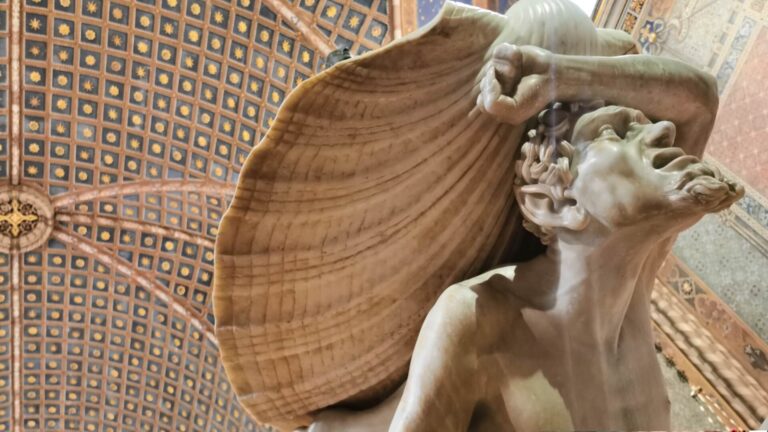ARTISTS’ ROADS
LE VIE DEGLI ARTISTI
watch the videos at the bottom of the page!
SANTA LUCIA DI PIAVE
The Devil and Holy Water
Riccardo Granzotto was born on 23 August 1900, in Santa Lucia di Piave.
He lost his father at the age of ten, and soon left school to work. He began as a cobbler, then a carpenter, and finally a mason in his brother Giovanni’s firm.
He showed a natural gift for drawing. Even his parish priest, Don Vittorio Morando, noticed it.
At twenty-one, Riccardo enrolled in the evening School of Arts and Crafts in Conegliano, where the sculptor Vittorio Celotti was teaching. A deep and lasting bond grew between the two. Celotti cared for this talented young man like a son, and encouraged him to study.
And so he did. From 1925 to 1929, Riccardo studied sculpture at the Accademia di Belle Arti in Venice, with excellent results.
For his first marble work, The Soul and Its Garment, he received praise from the master Adolfo Wildt, who was visiting the students.
He had yet to graduate when his parish priest, Don Vittorio, the first to believe in him, commissioned him to create a holy water stoup for the parish church.
Riccardo took the commission seriously. He created a masterpiece: a sculptural group in Carrara marble and bronze, transforming a simple vessel for holy water into a powerful narrative.
Saint Ignatius of Loyola once said that Satan “acts as a licentious lover in wanting to be secret and not revealed.” Here, Riccardo unmasks him, in all his beguiling beauty, and traps him beneath the weight of a scallop shell, from which rises the slender yet powerful figure of Mary.
Lucifer is a kind of Atlas, the Titan condemned by Zeus to carry the vault of the heavens on his shoulders. Riccardo would certainly have known the artistic interpretations of this myth. He was also likely familiar with the sixteenth-century Gobbo di Rialto in the Campo San Giacomo: how many times must he have stopped to admire it while walking through Venice?
The Lucifer of Santa Lucia di Piave is life-sized. A tangible presence, whose beautiful body reveals his divine origin. Yet the claws, pointed ears, and bat-like wings are unmistakable signs of his monstrosity. His right knee rests on the ground, while his left leg strains, in vain, to spring free from the crushing burden. His right arm hangs limp along his side. The left is raised to his brow. His fists are clenched.
The muscular tension culminates in his face, twisted in a grimace of pain and fury, distorting the mouth and baring the teeth. His stare is wild, lost in the void.
It recalls Wildt’s Mask of Pain and The Prisoner. The same twisted expression, the same goat-like beard. But Riccardo, ever in pursuit of harmony and purity, softens the drama.
From the Milanese master, he also borrowed a taste for mixing materials and for polished surfaces that suggest a refined transparency.
We still have a plaster model of the stoup, a precious record of how the final work evolved from the initial concept. Among the many changes: Lucifer’s posture, and the addition of a serpent’s skin girding his waist. The base became rectangular rather than quatrefoil, and the holy water basin changed from a simple round bowl into an elegant scallop shell, crafted in collaboration with his first mentor, Vittorio Celotti.
Completing the sculptural ensemble is Mary. A refined bronze figure echoing Donatello. A beautiful young girl, with her hair loose, steady as a Greek column. Her right hand rests on her chest in a gesture of assent. With her left, she points to the saving waters. She is the biblical woman who will crush the serpent’s head. Her upward gaze reveals her relationship with God, a song of praise to the Lord.
The holy water stoup was blessed on 8 December 1928. Riccardo was still studying. And in his heart, the thirst for God was already becoming irrepressible.
Other works of his art soon followed in this same church. In 1931, the porch with its majestic column-bearing lions. The main portal doors. And in 1933, the statue of the martyr Lucia. Once again, a nod to Wildt.
That same year, on 7 December, Riccardo entered the Order of Friars Minor, taking the name Brother Claudio. Since 1994, he has been beatified.
MORE EXPERIENCES!
Fra’ Claudio: tra santità e genio artistico:
- La gipsoteca a Santa Lucia di Piave
- Palazzo Ancilotto a Santa Lucia di Piave
- Museo diocesano d’arte sacra a Vittorio Veneto
- La chiesa dei Francescani a Vittorio Veneto
MULTIMEDIAL MAP: “ARTISTS’ ROADS – LE VIE DEGLI ARTISTI- EN”!

